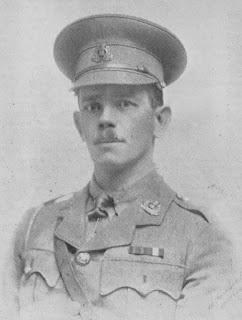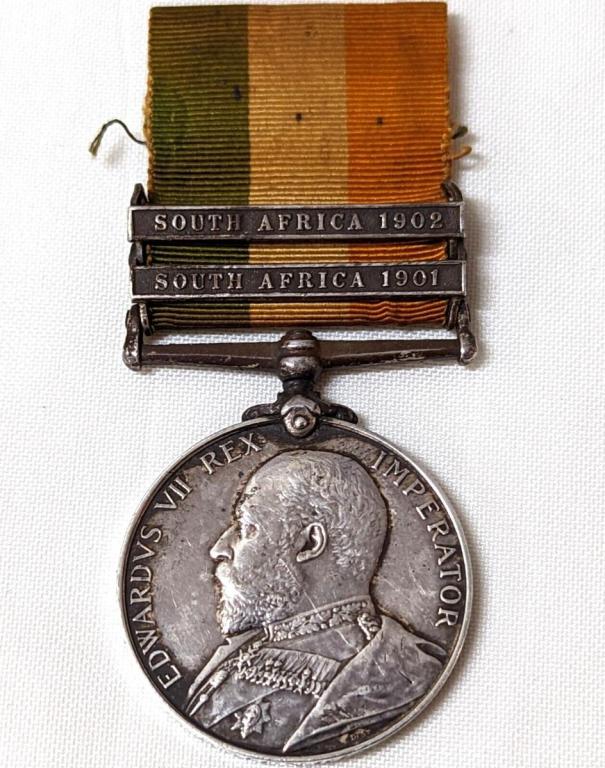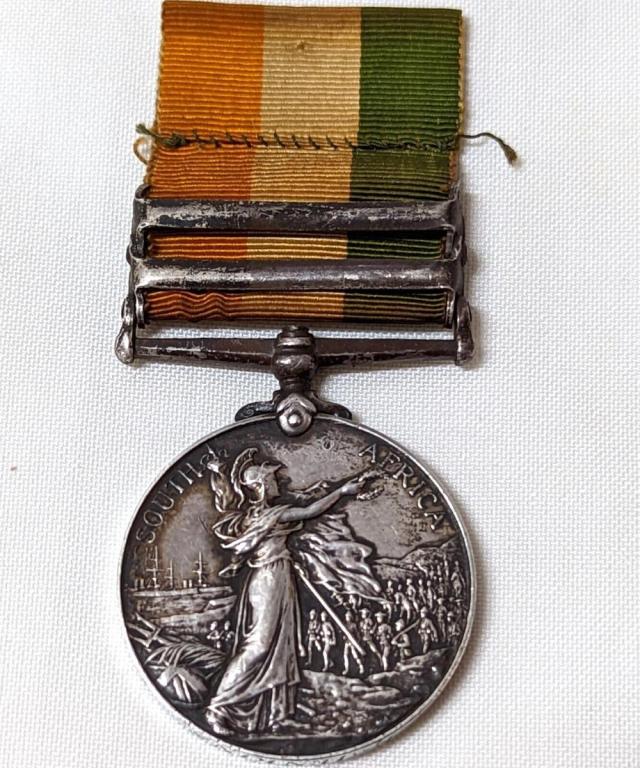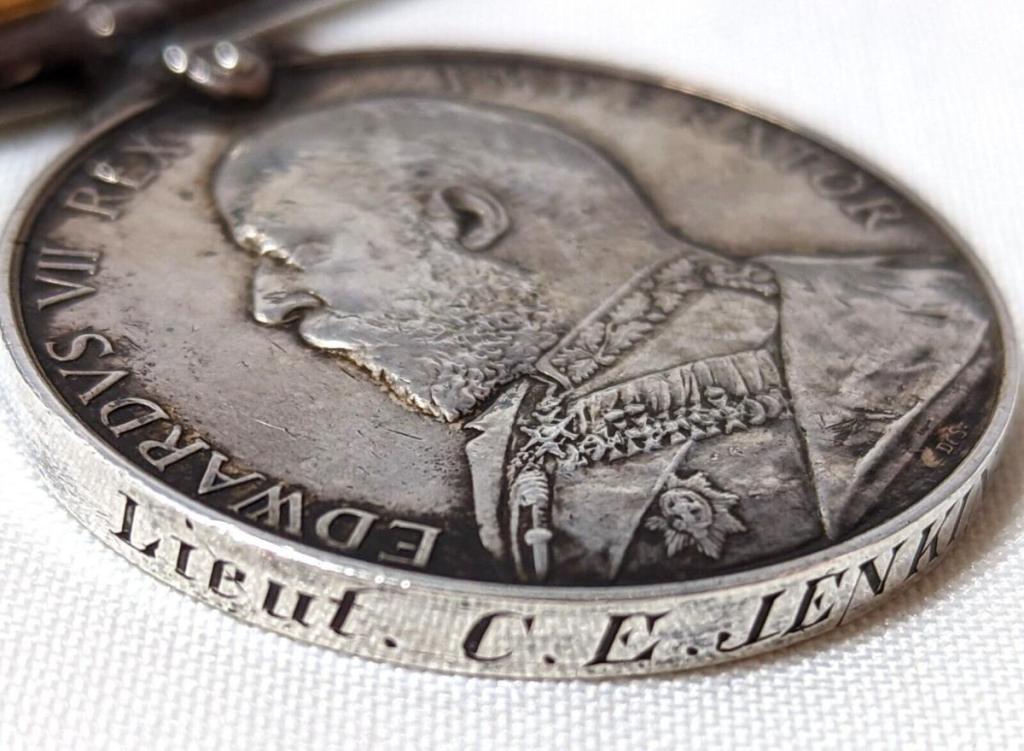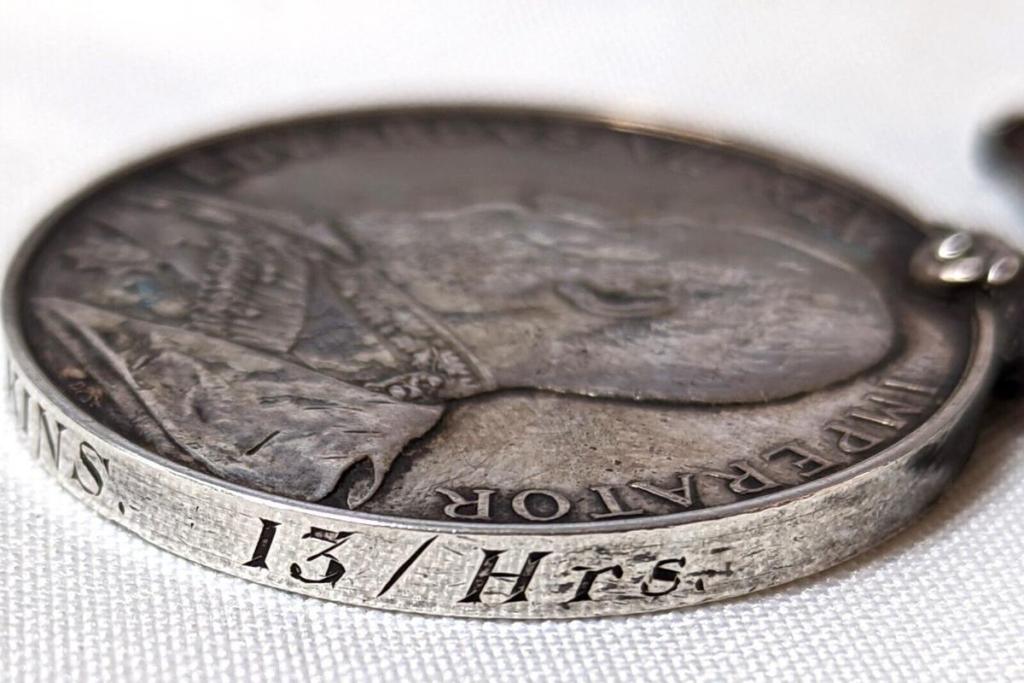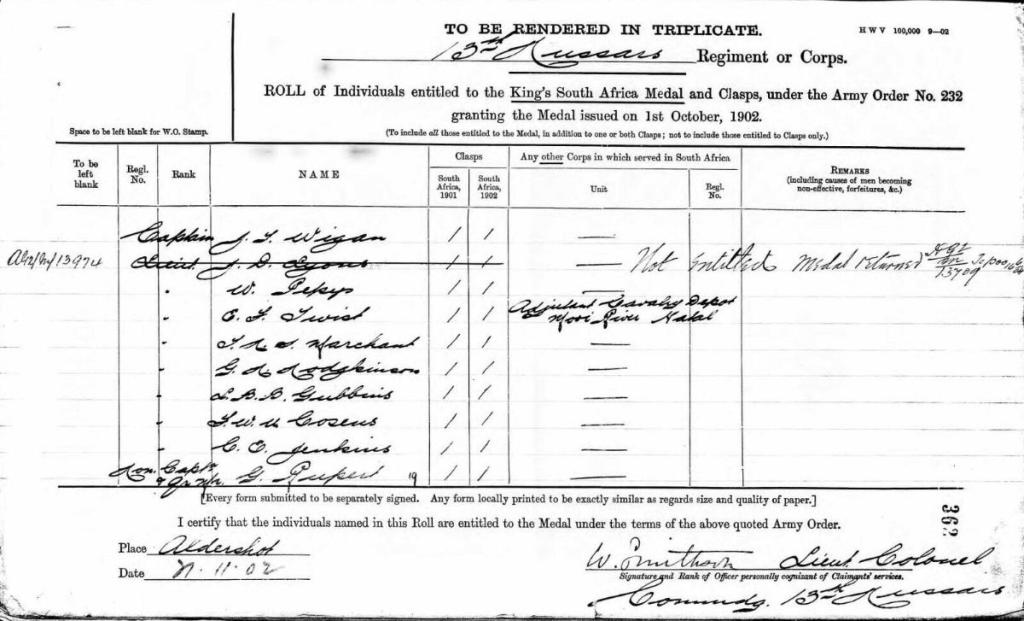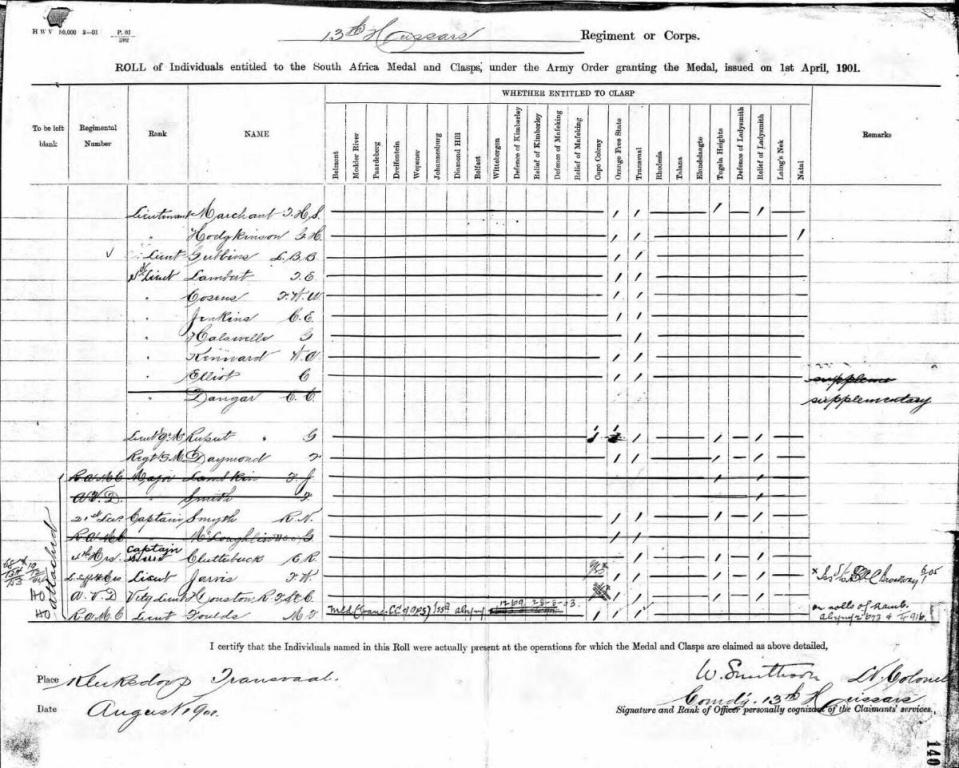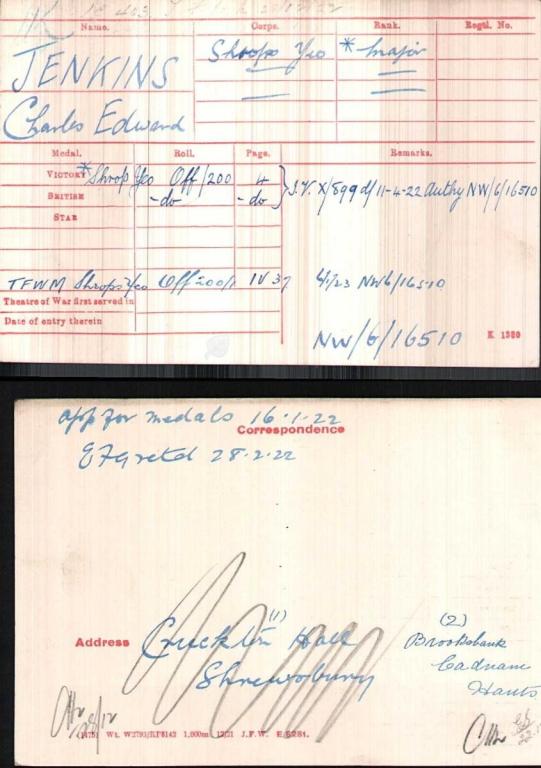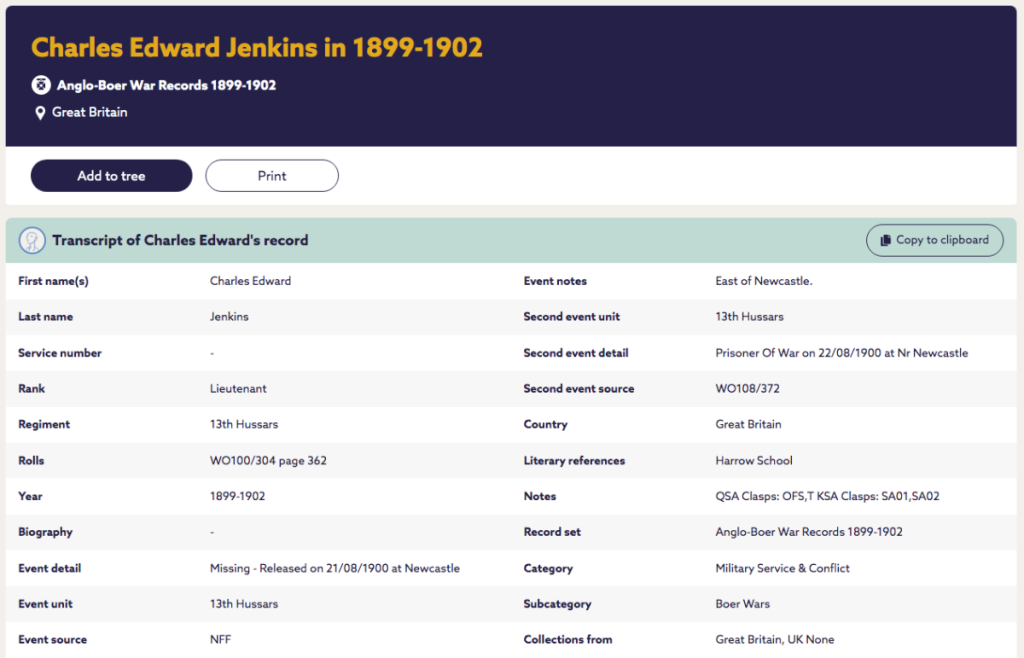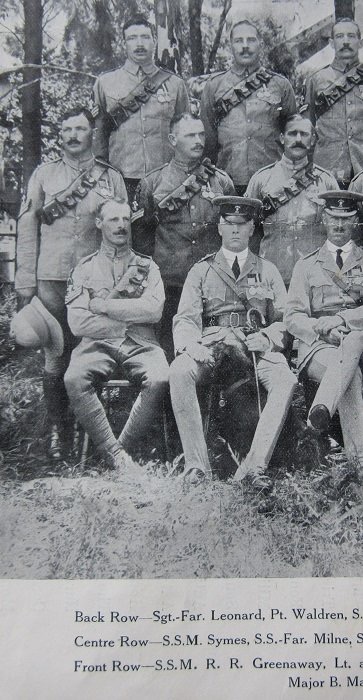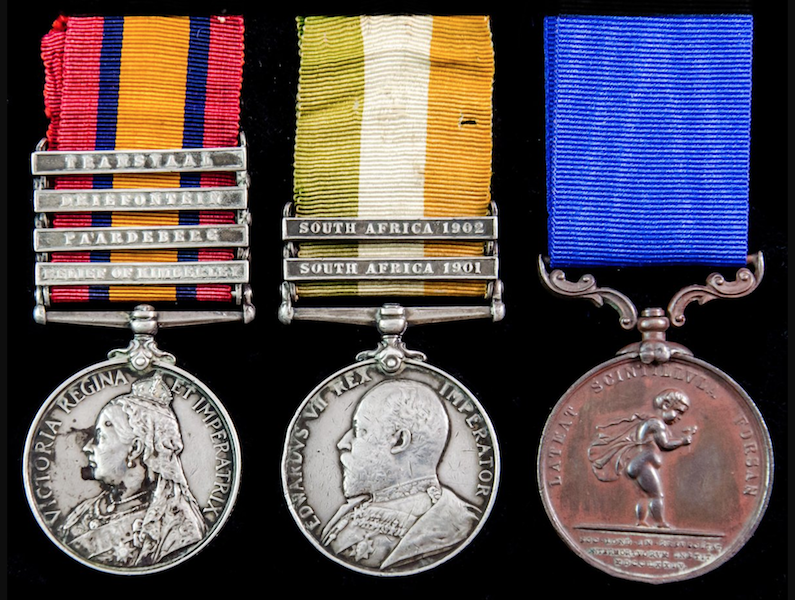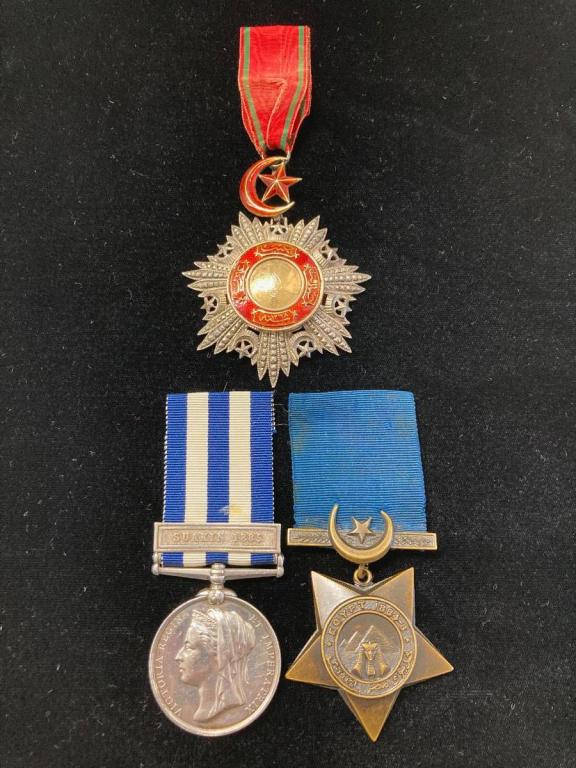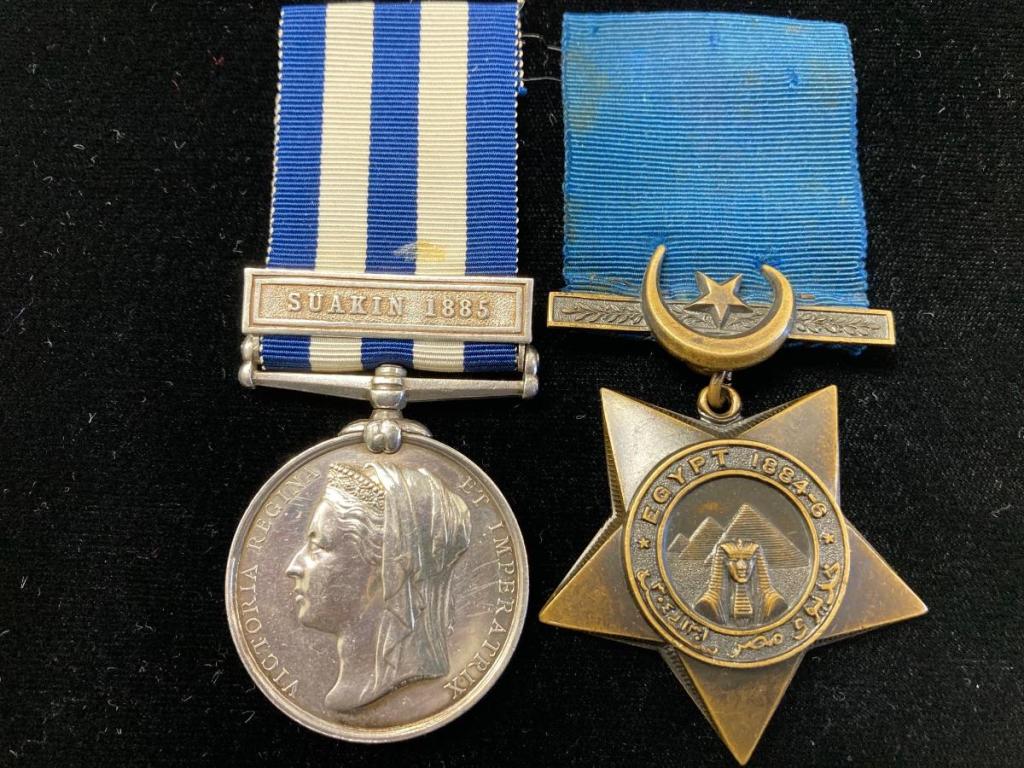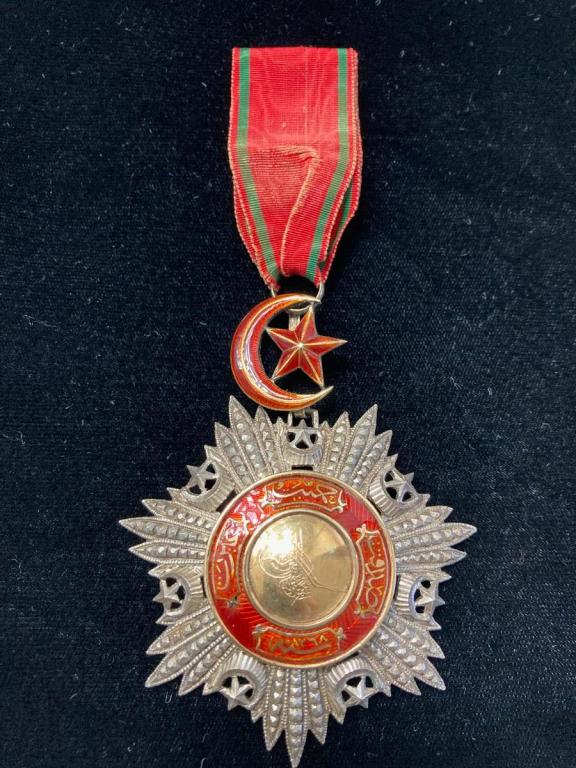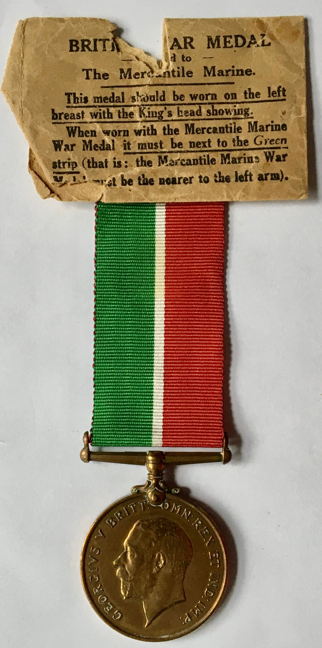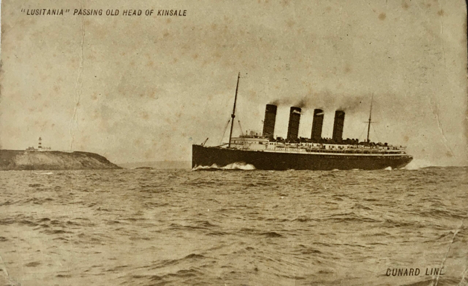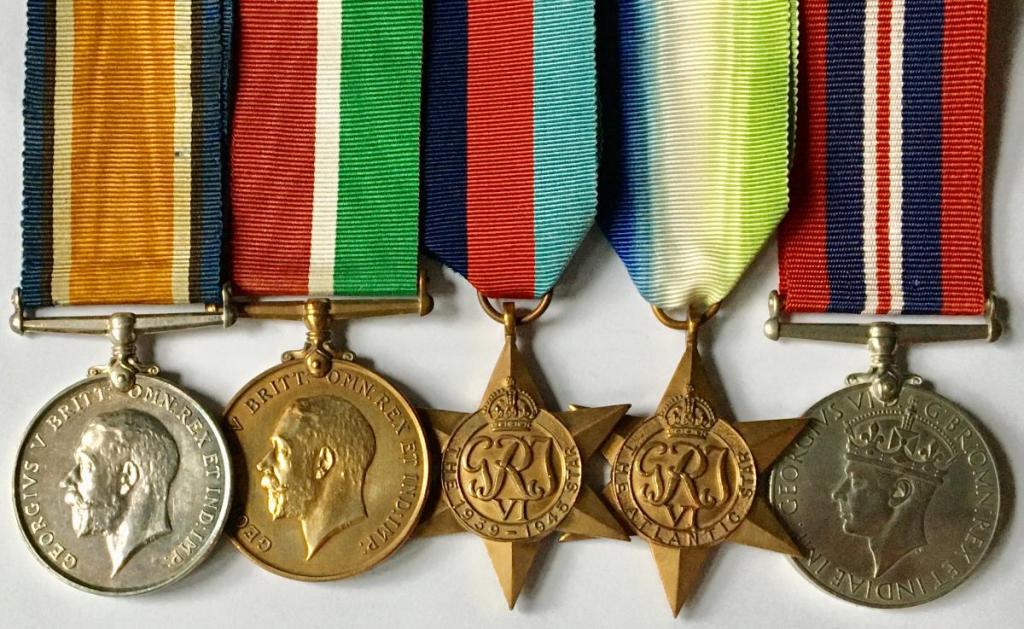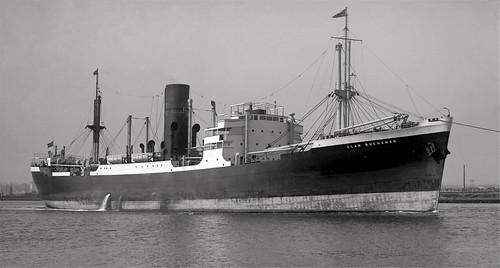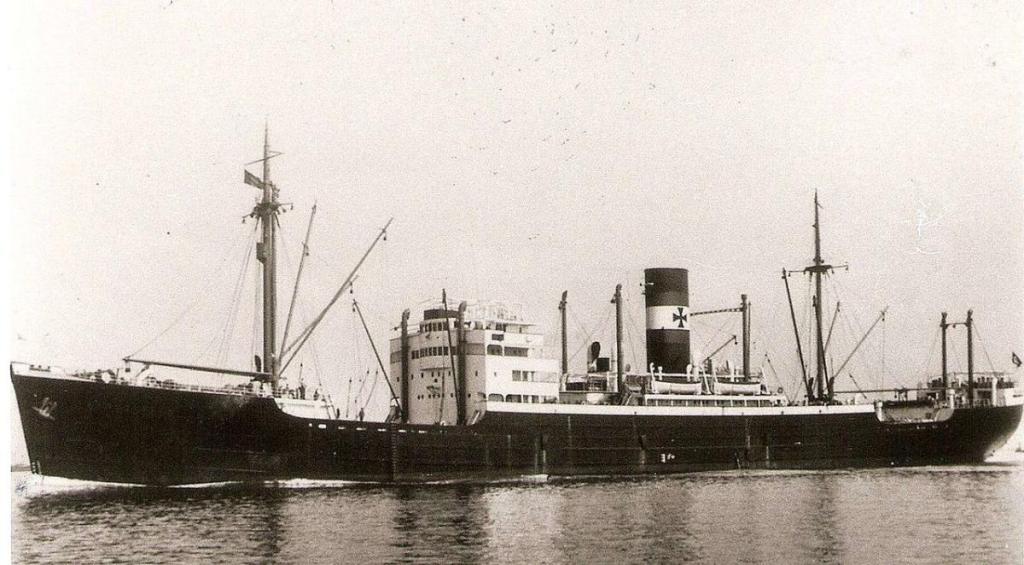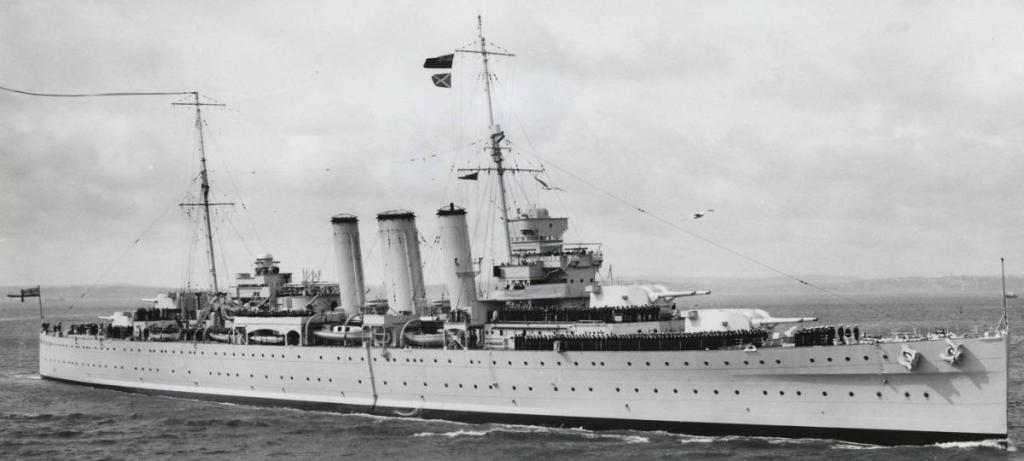-
Posts
1,770 -
Joined
-
Last visited
-
Days Won
3
Content Type
Profiles
Forums
Blogs
Gallery
Events
Store
Everything posted by azyeoman
-
It’s nice to see a cased one. Congrats.
-
Private Walter Day, Royal Berkshire Regiment, who was awarded the Royal Humane Society’s Bronze Medal for saving the life of a man from drowning at Roodevval Spruit, Orange River Colony, on 16 September 1900. There were only 93 RHS medals awarded during the Boer War; 8 silver and 85 bronze. Queen’s South Africa 1899-1902, 2 clasps, Cape Colony, Orange Free State (4838 Pte. W. Day, 2: R: Berks: Regt.); King’s South Africa 1901-02, 2 clasps, South Africa 1901, South Africa 1902 (4838 Pte. W. Day. Rl: Berks: Regt.) number officially corrected; Royal Humane Society, small bronze medal (successful) (J. Day. 2nd. Bttn: Berks: Regt, Sep. 16 1900.) with integral top bronze riband buckle. 23 October 1900 awards (supplementary list) 2nd Bn. Berkshire Regiment – 4838 Pte. W. DAY (a pond at Roodevval Spruit, Orange River Colony, 16 September 1900) ???? Private JONES (a pond at Roodevval Spruit, Orange River Colony, 16 September 1900) "On the 16th September 1900, J. J. LeRoux, the son of a local burgher, by holding on to the tail of a horse, was carried out some 25 yards from the bank in a pond at Roodevval Spruit, Orange River Colony. Seeing his danger, Jones and Day, who were bathing near, at once swam out, and at great risk rescued him". Entitled to: ’15 Star trio as 9855 Pte. Walter Day, Royal Berks. Regt. And the Labor Corps 611730 (646 Agriculture Coy. Please contact me if you know the location as I would like to reunite Day's entire group. Agricultural companies were originally formed on a regimental basis being men no longer fit to serve overseas who were hired to local farmers who were responsible for transferring the appropriate farming (or forestry) skills. The regiments were responsible for pay and rations and the farmers paid a sum (less than agricultural laborer’s rates) to the regiment. Most men were B2 or B3. As an example of how widespread this was between February 1916 and the end of the war the King's Own Royal Lancaster Regiment placed over 1,500 men into agricultural companies. Ironically, they could find themselves working alongside German POWs. In June 1917 the individual regimental companies operating in the U.K. were transferred to the Labor Corps. About 75,000 men were so employed. In France the RGA still had agricultural companies working in French forests supplying timber to the batteries. Walter Day was born in 1877/8 in Early, Maidenhead, Berks. He was the son of Joshua and Elizabeth Day and had four brothers (John, William, Jesse and Sidney) and two sisters (Lucy and Edith) He was a farm laborer. At 17 years old, he joined and served as a private (No. 5194 or 7) in the Militia (3rd Royal Berks) prior to enlisting at Reading on 9 Feb. 1897 when he was 19 years and two months old. He was COE. He as 5’4.5” tall and had brown hair and hazel eyes and a fresh complexion. He had a bugle tattoo on his right forearm. He served at home from 9/2/1894 to 12/2/1898; S. Africa from 13/2/1898 to 30/10/1902; Egypt from 31/10/1902 to 21/10/1904 and then at home from 22/10/1904 to 8/2/1909. He was “awarded Mounted Infantry Cert. at King William’s Town 31/12/1898 and awarded a certificate as having served with the Mounted Infantry in the field during the South African Campaign…” He accidentally injured his knee when not on duty 21/5/1897. His QSA is confirmed with the clasps CC, OFS, TR as is his RHS Bronze Medal and certificate for saving life from drowning on 16/9/1900 at Roodeval Spruit. His KSA with two claps is also confirmed. During WWI, Day enlisted when he was 37 years old and 31 days. His address was 49 Station Rd. Marlow, Bucks. He was married to Alice (nee Hill) and they had four children Dulcie Elizabeth, Arthur Reginald, Frederick Ronal and Mary Alexandra). He attested as 9855 Private on 18/8/1914 in the Royal Berkshire Regiment. He served at home from 18/8/1914 to 29/5/1915 when went to F & F on 30 May 1915. Records show that he was punished four times. On 2 March 1915 Absent from Tattoo for seven days until 8:15PM on 8 March 1915, he was given 8 days punishment. Later in the month on 14 March 1915 he was broke out of Barracks as a defaulter for two days, and given 10 days FP No.2. Later he was absent from Tattoo while at Brigade Training, and given 10 CB and then again he was absent from Tattoo for 10 days while at Divisional Training, until apprehended by the Civil Police at 11:15 AM on 11 February 1915 for which he was given 14 Days FP No. 2. He was admitted to hospital with myalgia (acute muscle pain) in April 1916. He was also hospitalized during the Spanish Flu pandemic, and had seven days sick leave with the Flu on 28 October 1918. He survived with no complications.He was transferred to the Labor Corps as 611730 Pte. On 20/7/1918, and returned home to depot in Oxford where he was posted to 646 Agricultural Company on 31/10/1918. He was transferred to the Army Reserve and demobilized on 12 March 1919 in Nottingham.
-
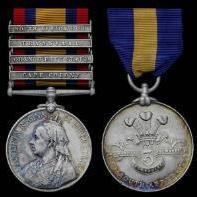
My Prisoner of War Collection
azyeoman replied to POWCollector's topic in Great Britain: Orders, Gallantry, Campaign Medals
What a fabulous addition. It’s an important historical museum quality document. Congratulations! I’m glad it’s archival framed; it should last longer than any of us reading this. 🙂 -
A First World War South African Forces German South West Africa and Battle of the Somme Prisoner of War trio with a happy ending. 1914-1915 Star; (SJT. A.W.R. SHAW 4TH INFANTRY) British War Medal South African issue bi-lingual Victory Medal; (SJT. A.W. REAY-SHAW. 1ST. S.A.I.) Allan Wilson Reay-Shaw, known as Allen Shaw, was born in 1894 in Grahamstown, Cape Province, SA. He was the son of John Reay-Shaw. He worked at the National Bank as a bank clerk, and enlisted on 14 August 1915 in Potchefstroom as 991 Private with D Company, 4th Infantry, the 1st Eastern Rifles. He was 6' tall, with dark hair and grey eyes, and had a scar on his right leg. He was promoted Sergeant on 10 September 1915. He served as a Sergeant with ‘D’ Company, 1st Eastern Rifles during the campaign in German South West Africa in 1914 and 1915, and was discharged in June 1915. He then re-enlisted into the South African Overseas Expeditionary Force in August 1915, and served as a 1079 Sergeant with ‘B’ Company (recruited from the Eastern Province), 1st South African Infantry Regiment. He sailed for Europe on the SS Durham Castle from 20 September to 11 October 1915 when he landed in England. He went to France on 27 July 1916 where his regiment was attached to the 9th (Scottish) Division. He joined his regiment at Delville Wood, and was on the Western Front from 25 July 1916. He fought in the Battle of the Somme at Delville Wood, but not in the famous battle where the SA Infantry fought off the Germans. He was taken prisoner of war during the attack on the Butte de Warlencourt position (see below) on 18th October 1916. He was initially listed as killed in action; however, his parents received a cablegram from London stating he was "quite well...love",,, He was a PoW in Germany from 18 October 1916 to 17 December 1918. He repatriated on the SS Huntsgreen and landed in Hull on 31 January 1919. He as given a furlough from 2 February to 21 February 1919 and then sailed to South Africa on the SS Orita and was struck "off strength" on 16 March 1919. discharged on 7th May 1919. Interestingly, his "Proceedings on Discharge" form signed by Reay-Shaw and dated 7 May 1919 at Maitland, Cape, states that he refused dental treatment, but also has typed the following: " I have retained my uniform, greatcoat and blankets on condition that these articles are neither sold nor possession of same transferred to any other person without the sanction of the Discharging Officer, or nearest District Staff Officer. I have been warned not to wear my uniform after the expiration of my 28 days furlough, and have received a cash payment with which to purchase a suit of civilian clothing." Butte de Warlencourt in 1918 Butte de Warlencourt today. The attacks on the Butte de Warlencourt (7 October – 16 November 1916) describe a tactical incident during the Battle of the Somme. The Butte de Warlencourt is an ancient burial mound off the Albert-Bapaume road, north-east of Le Sars in the Somme Department in northern France. It is located on the territory of the commune of Warlencourt-Eaucourt and slightly north of a minor road to Gueudecourt and Eaucourt l'Abbaye. During the First World War, German troops constructed deep dugouts in the Butte and surrounded it by several belts of barbed wire, making it a formidable defensive position in advance of Gallwitz Riegel (Gird Trenches to the British). After the Battle of Flers-Courcelette (15–22 September 1916), the view from the Butte dominated the new British front line and was used by the Germans for artillery observation. During the Battle of Le Transloy (1–20 October 1916), the Butte de Warlencourt was the subject of several attacks by the British Fourth Army, which were costly failures; attacks in November were also defeated. 18 October On 17 October, as two companies of Infantry Regiment 104 counter-attacked, they were confronted by a "gigantic iron dragon" (a tank) which fired on German positions with machine-guns and light guns. Most of the 9th Company was annihilated before the tank retired. The capture of the Butte by the 9th (Scottish) Division was postponed and Snag Trench was made the objective of an attack at 3:40 a.m. on 18 October. On the right flank an attack was to be made by the 30th Division. The 26th Brigade was to attack with a battalion in line, the four companies moving on platoon fronts with a supporting company and a machine-gun company; Stokes mortars were to add to the bombardment of the German front line. On the left flank, the South African Brigade was to attack with the 1st Regiment, with three companies in line, also on platoon fronts, one company in support and one in reserve. The weather broke again and the attack took place in a deluge. On the right, the battalion advanced close to the creeping barrage and rushed Snag Trench as the standing barrage lifted; the garrison ran back to the Gird trenches. A counter-attack began after fifteen minutes, bombed back into the trench on the right and was repulsed soon after. On the left, the South African left flank was repulsed and contact was lost with the right flank units until 9:30 a.m., when a Lewis gun crew made contact with the 26th Brigade battalion, which had also met troops of the 30th Division. In the afternoon, a party of German troops were seen massing for a counter-attack and were dispersed by artillery and small arms fire. At 5:30 p.m. a counter-attack on the left was also repulsed. During the night a British pioneer company arrived and dug a communication trench back to the old front line. The Lewis gun team was the only South African party to reach the objective; the center and right-hand companies disappeared, apart from the Lewis gunners and a few wounded. It was thought that the South Africans overran Snag Trench, which was unrecognizable and were cut down by the machine-guns at the Butte; a few stragglers returned later in the day with 19 prisoners. The left flank company was stopped by uncut wire and then caught by machine-gun fire, which inflicted many casualties; the remaining troops retired to the British front line. Furse ordered another attack for 5:45 p.m. and for the main German strong point the Nose to be bombarded, before the South Africans captured it and formed a trench block 500 yd (457 m) up Tail Trench. The rainstorm had turned the ground into a sea of mud so deep that moving 1,000 yd (914 m) took four hours. A company was to attack from the Pimple and another was to get into Snag Trench east of the Nose and attack westwards. The attack from the Pimple entered a hollow, full of German machine-gun nests which stopped the advance. The South African party got into Snag Trench and advanced to within 25 yd (23 m) of the Nose and were then repulsed by the fire of three machine-guns, reoccupying Snag Trench a few hours later.
-

My Prisoner of War Collection
azyeoman replied to POWCollector's topic in Great Britain: Orders, Gallantry, Campaign Medals
Another great acquisition for your excellent PoW collection! I really enjoyed the story on this one. -
I have just acquired another Egypt 1882 Medal without clasp officially named to: Interpr. R. Conduris who replaced the suspension with a ring. Perhaps he used it as a watch fob. Nevertheless, it's a fine addition and here is what is known about the medal recipient. The ‘Register of civilians employed during the Egyptian campaign’ records a ‘Dem. Cunduris’ was engaged at Limassol on 22 August 1882 and spoke Greek, English and Italian. He was initially paid at a rate of 6 shillings and 6 pence a day (raised to 10 shillings from 2 September) – in comparison, a superintendent of transport was paid 5 shillings and a driver 2 shillings (register, WO 61/15, TNA). It is logical to assume that these two individuals are the same as there is no other ‘Cunduris’ or variant on the medal roll, and errors are known to have happened in the naming of many British medals. Later, a 'D. Conduris' applied for employment with the Government of Cyprus in 1884/5. Any further information on Cunduris would be greatly appreciated. Medals to interpreters are not often encountered and I have been fortunate to find three of them, which have been posted on this forum.
- 1 reply
-
1
-

Bronze BWM collection
azyeoman replied to Brian Wolfe's topic in Great Britain: Orders, Gallantry, Campaign Medals
A few more from left to right: No. 70263. Chinese L.C. awarded to Wang Fe Lin (horizontal-top 3) 24078 Pte. P. Masilikatsi S.A.N.L.C. 6240 N. Mercieca. Maltese L.C. 5158 Muleteer Macedionian Mule C. on original ribbon with handmade Union Jack stitched to it. MIC states it was awarded to 5158 Multr Pantelis Christou Mace Mule C. ( Roll MMC.101.A3 page III) Also two interesting books on the CLC. James' book is the definitive work on the Chinese Labour Corps, and is a massive tome at 1,285 pages. Klein, Darul 2nd Lt. With the Chinks in the Chinese Labour Corps. London, Imperial War Museum James, Gregory The Chinese Labour Corps (1916-1920) Hong Kong, Bayview Educational 2013 -
522 - Norman Gooding CStJ, MA 1938-2022 It with great sadness that the Society records the death of Norman Gooding on 28thDecember 2022. Norman undertook his National Service in the RAF between 1957-59 and joined the OMRS in 1963. For many years his collecting activities were based around awards to the RAF but, in 1990, he disposed of his RAF collection and focussed his interest on medals and awards to uniformed women’s organisations, a field in which he was to become a recognised expert. Norman’s service to the Society was extensive; his first formal role was Auction Organiser, which he undertook from 1965. In 1966, he was elected General Secretary and served under eight different Presidents, finally retiring in 2000 after 34 years in post. He subsequently served two terms as President – the first between 2001 and 2005, and the second from 2009 to 2011. He continued to serve the Society actively both as a Trustee and member of the Executive Committee until his death. Norman contributed extensively to the OMRS Journal, having well over a hundred articles published. He also published a number of highly regarded books on honours and awards to women. Those who served with him valued his encyclopaedic knowledge of the Society’s affairs and his measured contributions to even to the most contentious of issues. Norman’s service to the Society was recognised by the award of the Society’s Distinguished Service Medal in 1976 and the award of the bar to the Distinguished Service Medal in 1999. The Society requests that Members respect his wife Jean’s privacy at this time. Any Member wishing to express their condolences should do so by emailing the General Secretary, Graham Grist generalsecretary@omrs.org A full obituary will appear in the March edition of the Journal. Dr Richard Emsley Thank you Norman for all you did. RIP
-
It appears to be a facsimile as there are no darker areas that a true ink signature would have with the nib writing over previously made lines. It isn’t uncommon to find facsimile signatures of the sovereign; e.g., condolence letters and welcome-home letters to returned PoWs. There were/are so many awards and decorations given out that it is unusual to find a document actually signed the King or Queen. It would look nice to frame the document with the appropriate OBE (GVI).
-
Another very nice Boer War PoW additionn. consisting of a QSA with RoK, Paard, Drie, Joburg, DH, and a KSA with SA01, SA02 named to 26646 Dvr. A. G. Willis RHA Alfred George Willis a 19-year-old laborer from Islington who enlisted into the Royal Horse Artillery at Dalston in 1898. He served in south Africa from October 1899 until November 1902, and was discharged in 1910. He was taken prisoner of war at Uitval's Nek on the 11th of July 1900. While in South Africa, Willis took part in the expedition to Koodosberg Drift in beginning of February 1900, and in the relief of Kimberley, and in the subsequent advances to Bloemfontein and Pretoria. A section was with a squadron of the Scots Greys and the Lincolns in the disaster at Nitral's or Uitval Nek, 11th July 1900 when the guns were lost. It was dawn on 11th July 1900, that the troops were fired upon from two unoccupied peaks above the pass. The Boer Burghers, under Assistant Commandant-General J.H. de la Rey then charged the guns and captured them in their position at Uitval Nek, another name for Silkaats Nek, it being named after a farm located just to the south of the pass. The by late afternoon the entire pass had been taken by the Boers. The squadron of Scots Greys together with the commanding officer, adjutant and 84 men of the Lincolnshire Regiment, along with all the surviving men of the artillery, were taken prisoner, and British losses numbered 24 killed and 44 wounded, and 198 taken prisoner, with Willis among the latter number. This action was one of the first successful actions which marked the beginning of the guerrilla warfare aspect of the Boer War. De le Rey’s force, had launched a three pronged attack which eventually surrounded the British force, and despite a gallant defence, the British and Colonial troops were forced to surrender. For more information, see the above post in this thread to 72665 Gnr. E.W. Pearcy, O Batt. RHA who was captured with Willis at Uitsval's Nek also known as Nitral's Nek, Silkaatsnek, or Zilikat's Nek.
-
It's been a long while since I added a WWII PoW medal recipient to the collection. I've always wanted one to someone who was captured in the Normandy campaign and Private Earnest Reynolds medal does indeed fit that. Earnest Reynolds was born on 06/12/1907. He was a member of the Church of England. He served as private 6006992 with the 2nd Bn. Essex in India and was awarded the IGS 1908 with North West Frontier 1930-31 clasp. He returned to England and was a painter and decorator. He was 5’6.25”, weighed 130.5 Lbs, and had black hair and blue grey eyes. He reenlisted as private 6030423 on 31/03/1941 in the 2nd Bn. Essex. The battalion received large drafts of men to bring it up to strength and began training intensively for the Allied invasion of France. The battalion and brigade landed as part of the second wave on Gold Beach on D-Day, Gold Beach from roughly 1:00 pm and immediately set off inland. For his WWII service, Reynolds in entitled to the 1939 and France & Germany Stars, the Defence Medal and the War Medal. Gold Beach, was the central beach of the Normandy invasion on 6 June 1944. It was located between Port-en-Bessin on the west and the Lieu-dit La Rivière in Ver-sur-Mer on the east. High cliffs at the western end of the zone meant that the landings took place on the flat section, code-named Jig and King, between Le Hamel and La Rivière. The British Army was responsible for taking Gold with the Royal Navy providing sea transport, mine sweeping, and a naval bombardment. Dutch, Polish and other Allied ships participated as well. The objectives were to secure a beachhead, capture Arromanches to the West, establish contact with the American forces at Omaha Beach, capture Bayeux and the port at Port-en-Bessin, and then link up with the Canadian forces at Juno Beach to the east. The British on Gold faced elements of the German 352nd and 716th Infantry Division consisting of about 2,000 men were in improved fortifications under the leadership of Generalfeldmarschall Erwin Rommel. On D-Day at Gold, naval bombardment started at 05:30, and amphibious landings launched at 07:25. High winds made conditions difficult for the landing craft, and the amphibious DD tanks were released close to shore or directly on the beach instead of further out as planned. Three of the four guns in a large emplacement at the Longues-sur Mer battery were disabled by direct hits from the cruisers Ajax and Argonaut at 06:20. The fourth gun fired sporadically in the afternoon; its garrison surrendered on 7 June. Aerial attacks had failed to hit the Le Hamel strongpoint, which had an embrasure facing east to provide enfilade fire along the beach. Its 75 mm gun continued to do damage until 16:00, when an Armored Vehicle Royal Engineers (AVRE) tank fired a large petard bomb into its rear entrance. A second casemated emplacement at La Rivière containing an 88 mm gun was neutralized by a tank at 07:30. Infantry began clearing the heavily fortified houses along the shore and advanced on targets further inland. The British 47th Royal Marine Commandos captured Port-en-Bessin on 7 June. On the western flank, the 1st Battalion, Hampshire Regiment captured Arromanches, and 69th Infantry Brigade made contact with the Canadian forces at Juno on the eastern flank. Stiff resistance from the German 352nd Infantry Division, meant Bayeux was not captured until the next day. British casualties at Gold are estimated at 1,000–1,100. German casualties are unknown. Pockets of German resistance remained throughout the beachhead area and the British were stopped about 3.7 miles (6.0 km) short of their D-Day objectives. Bayeux, a primary D-Day objective for 50th Division, was captured on 7 June. By the end of D-Day, the 50th Division had lost around 700 men. Total casualties, from all units involved in operations at Gold, were in the region of 1,000–1,100 casualties, of which 350 were killed. German losses are unknown; at least 1,000 were captured. By the end of D-Day, 24,970 men had been landed at Gold, along with 2,100 vehicles and 1,000 tons of supplies. The 56th Independent Infantry Brigade, in which the 2nd Battalion Essex was part and where Pte. Earnest Reynolds was serving, was reformed in the United Kingdom on 15 February 1944. The brigade consisted of three Regular Army infantry battalions that had all seen service overseas: the 2nd Battalion South Wales Borders (SWB), which had fought in the Norwegian Campaign in 1940, and the 2nd Battalions of the Essex and Gloucestershire Regiments, which had both fought at Dunkirk in 1940. The 56th Brigade took part in the D-Day landings on 6 June 1944, where it formed the right flank of the 50th Northumbrian Division on Gold Beach. It remained attached to the 50th Division until 10 June, after which it was attached to the 7th Armored Division 12 June, then reverting to the 50th Division and came under command of the 59th Staffordshire Infantry Division in early August 1944. Pte. Reynolds would only serve in the 50th Division as he was captured on 11 June along with at least 16 other rankers and one officer of Company B. One member of the 2nd Battalion Essex described the landings as such: As midday approached the craft nosed their way into the land and we could see plainly the coast line. Something akin to consternation was caused when we found that we could not reconcile the appearance of the land with the models we had memorized in Camp B3. LE HAMEL, where we were due to land, was still not free and it was thus necessary to go ashore some mile and a quarter to the East. The sea held much evidence of tragedies already enacted, wrecked landing craft and vehicles, disabled tanks, floating compo boxes and items of equipment. At 1225 hours the leading craft grounded the ramps went down and the men streamed ashore. Some into water only knee deep, others up to their necks but all made dry land, crossed the short stretch of shingle and clambered over the low sea wall. A quarter of a mile to the left our transport, including all "S" Company vehicles was having a much more difficult time. Mines were encountered by the score and the few clear lanes were blocked by bogged or "drowned" lorries and tanks. The sea wall, low though it was, increased the problems but somehow all were overcome. According to plan, we formed up in boat-loads and moved off to the prearranged assembly area near RYES, some 2 1/2 miles inland. On the rising ground to our left we could see a long line of Shermans forming up and we gasped as we saw that they were parked almost head to tail. As we marched along we saw and heard German beach defenses still holding out but our orders were to get inland and we pushed on. Past small batches of prisoners we went, through minefields already gapped. Numbers of dead and wounded from both sides littered the roads, some hurriedly but efficiently dressed by the SBs but others as yet untouched and we could not help them. The roads along which we marched were now being shelled by 75s at short range but casualties were few and soon we came to the assembly area, quickly deployed and dug in for the first this. The area was in a small wood not entirely clear and the odd sniper was still operating. A row of large poplars caused us same trouble until a Sherman come up and one by one picked off the two tops where the snipers were concealed. In the early afternoon we checked up and found that apart from a Signals 15 cwt., "A" Company's No. 1 15 cwt. and the Pioneer's Jeep which had been drowned, we were all present. The initial stage in the de-waterproofing of vehicles was carried out; Mae Wests discarded and we were ready for the first Job - the capture of BAYEUX, a large and important road and rail Cathedral City, some 6 miles from the coast and almost due South of ARROMANCHES On 11 June, when Reynold’s was captured, the battalion was sent to occupy Berniers Bocage at 0900. At noon, the battalion was order to secure the woods north of Lingeveres. The wood was subjected to concentrated artillery fire and companies A & C moved on the objective under a lifting barrage. The Essex held the wood, which was on a forward slope and was an awful defensive position. There were two Mk V tanks engaging A Co. and the Germans quickly counter attacked with mortar fire, infantry and a flame-throwing half-track causing heavy casualties. The Essex beat of several of them, but the battalion was ordered back on the night of the 12th. Lt. Smith and 16 other ranks of Company B were reported missing on 11 June. Here is a good detailed account from the book Tilly sur Seulles by Stéphane Jacquet. On 10 June 1944, the British launched a naval artillery fire by the light cruiser HMS Orion. Despite this deluge of fire and steel, the Germans hold fast. The next day, June 11, 22nd Armored Brigade of Brigadier W. R. N. Hinde belonging to the 7th Armored Division approached Lingèvres by the north. Squadron A of the 5th Royal Tank Regiment supports the infantry of Company I of the 1st Battalion Rifle Brigade in the Lingèvres Forest: the tanks are taken to task by German tanks while an ambush is stretched to the English soldiers in the forest. These elements fell and the order was given at noon to the 2nd Battalion Essex Regiment (56th Infantry Brigade), then located in the village of Bernières about 2 kilometers north-west, to seize the forest of Lingèvres Era located near the farm of the Verrières). Guided by the corps commander of 2nd Battalion Essex, Lieutenant-Colonel J. F. Higson, companies A (left) and C (right) are in the first step, companies B and D in second step. While the British were engaged in the discovery north of Lingèvres, the Germans opened fire with their machine guns, artillery and tanks (including two Panther tanks); The wounded and the dead litter the battlefield and the soldiers rush to the shelter in the forest. Two Messerschmit BF 109 fighter ships flying low and strafing the Company A sector. Lieutenant-Colonel Higson ordered his men to cover and dig battle holes to spend the night; SdKfz 251 with flamethrowers attacked the English positions but when one of the vehicles was destroyed, the others fell back. During the night, General E. C. Pepper (commander of the 56th Infantry Brigade) set up several artillery supports in support of the withdrawal of the 2nd Essex which begins at the first light of 12 June and lasts all day. The regiment lost 150 soldiers during this engagement (killed, wounded, or taken prisoner), and on command, the Lieutenant-Colonel was relieved of his duties and replaced by his deputy, Major Elliott. Pte. Reynolds was PoW No. 82176 and he was held in Stalag VIIA in Görlitz; today it's the Polish town of Zgorzelec. It was originally set up as a Hitler Youth camp, converted in October 1939 to house both Polish soldiers and civilians. Later held up to 30,000 Allied prisoner PoWs, including Americans, Australians, Belgians, Britons, Canadians, French, Italians, New Zealanders, Slovaks, South Africans and Yugoslavs before its evacuation in February 1945. Its most famous inmate was French composer Olivier Messiaen. On 14 February 1945 the Americans and British, along with Pte. Reynolds, were forced on a death march out of the camp westward in advance of the Soviet offensive into Germany. The evacuation process was gradually carried out until May 1945. The evacuation took place on foot, with all means of transport driving in front of the people for military purposes. The Death March claimed many victims. Some of the prisoners were taken to Bavaria, and others to Thuringia, where they were freed by the Allies. The last evacuation of the camp took place on 7 May 1945, when the Soviet army freed the prisoners.
-
Here's another fine addition and goes along with the other three Lindley PoWs that have been posted above in this thread. QSA with CC, OFS, - 14240 TPR. R.M.B. NEEDHAM, 47th Coy, 13th IY. PoW Lindley. MID and DSO M.I.D. 23 June 1902. M.I.D. Gazetted 6 Dec 1916. Distinguished Service Order Gazetted 2 Jan 1918. Roderick Macaulay Bernard Needham was born in Port of Spain, Trinidad on 28 Dec 1879 and first served with the 47th (Duke of Cambridge's Own) Company 13th Battalion Imperial Yeomanry. He was taken Prisoner of War on 31 May 1900 at Lindley and released on 5 Sep 1900 at Nooitgedacht, then commissioned 2nd Lieutenant into the 1st Battalion, Suffolk Regiment and promoted to Lieutenant with Bethune's Mounted Infantry, later Mentioned in Dispatches on 23 June 1902, when Colonel Bethune was made C.B. Before WWI Needham served as an officer with the West African Regiment, rejoining the Suffolk Regiment as a Captain during WWI and attached to the Royal West Surrey Regiment. Disembarking on 5 Nov 1914, Needham is further entitled to the 1914 Trio and Distinguished Service Order George V. Needham reached the rank of Lieutenant-Colonel before the end of WWI. If you know the locations of his DSO and '14 Star Trio, please contact me as I'd like to reunite the group. Thank you.
-
A very nice addition, but sadly missing his QSA, BWM, Victory and TFWM. Kings South Africa Medal (1902), with 2 clasps SOUTH AFRICA 1901, SOUTH AFRICA 1902, correctly hand engraved naming to: Lieut. C. E. JENKINS. 13/ Hrs. Major Charles Edward Jenkins was born on 6/3/1875 in Umbelea, India. His father was serving at the time in the Bengal Staff Corps, his grandfather was Major General Jenkins. He attended Harrow. He was gazetted into the 3rd Battalion Kings Shropshire Light Infantry (Militia) 23/12/1896 as a 2nd Lieutenant, he was gazetted with a regular commission into the 13th Hussars in December 1899. The regiment arrived in South Africa in the beginning of December 1899 in time to be present at the battle of Colenso. He was initially reported as ‘missing’ and released on the 21st August 1900 near Newcastle and then was classified as PoW on 22/08/1900 near Newcastle. He was hospitalized with enteric fever (Typhoid) in late 1900. He survived and returned with the regiment to Southampton in October 1902 where he resigned his commission on 17/12/1902. He inherited Cruckton estate, near Shrewsbury about this time, and married Muriel Taylor daughter of Major General Taylor R.A. in 1904. He also re-joined the Militia about this time serving with the Shropshire Yeomanry, with whom he served with as a Major during the great war. The regiment sailed to Egypt on 4/3/1916. On arrival the brigade merged with South Wales Mounted Brigade and formed the 4th Dismounted Brigade. 2/3/1917 it merged with 1/1st Cheshire Yeomanry to form the 10th (Shropshire & Cheshire Yeomanry) Battalion, the King’s Shropshire Light Infantry and came under orders of 231st Brigade in 74th (Yeomanry) Division and was deployed to France in May 1918. He survived the war and received his pilot’s license in 1934 with his occupation listed as retired Major. He died on 25/1/1949 at Hampshire, England. He was entitled to the Queens South Africa Medal with clasps Orange Free State, Transvaal. The British War and Victory Medals (1914 – 18) and the Territorial Forces War Medal. Please contact if you know the location of his medals as I would like to reunite them.
-
The nominal roll has been published on another site: https://www.angloboerwar.com/medals-and-awards/243-tribute-medals/r/4524-royal-humane-society There were only 93 RHS medals awarded during the Boer War - 8 silver and 85 bronze. Shoeing-smith Milne was gazetted in the Army & Navy Gazette on 22 March 1902 and the citation is as follows: 12 Lancers. - Shoeing-smith J. Milne has been awarded the medal of the Royal Humane Society for his daring rescue of Trooper South from the Olifant's River at Arnold's Drift, on Sept. 18, 1901. The trooper was swept from his horse while crossing the river, and his bandolier getting round his neck, which kept his head under water, Milne at great risk to his life went to his rescue.
-
Group of 3: Queen’s South Africa Medal 1899-1902, 4 Clasps: Relief of Kimberley, Paardeberg, Driefontein, Transvaal; (3962 S-STH: J. MILNE, 12: R: LANCERS); King’s South Africa Medal 1901-1902, 2 Clasp: South Africa 1901, South Africa 1902; (3962 CPL. SHG:-STH: J. MILNE. 12TH LANCERS.); Royal Humane Society Lifesaving Medal in Bronze for a Successful Act, 2nd type; (J. MILNE 12TH: LANCERS. SEP: 18. 1901.) If anyone knows the location of Milne's Army LSGC (GV), please contact me as I would like to reunite the group. John R. Milne was born in Newcastle upon Tyne, Northumberland, and worked as a labourer. He had served in the 3rd Militia Battalion, Northumberland Fusiliers, before attesting for regular service with the British Army on 6 January 1896. He joined the 12th Royal Lancers as a Private (No.3962) on 15 January at Ballincollig. He was appointed to Shoeing Smith on 19 July 1899, He was posted to South Africa from 22 October 1899, and was present at the relief of Kimberley on 15 February 1900, and at Paardeberg from 17 to 26 February 1900, and then at Driefontein on 10 March 1900. He also served on operations in the Transvaal. While on active service in South Africa, he saved the life of a fellow soldier in the 12th Lancers while crossing the Oliphant’s River at Arnold’s Drift in the Transvaal on 18 September 1901. He was awarded the Royal Humane Society Lifesaving Medal in Bronze for a Successful Act, Case No.31801. It was published in the Society Report and he was awarded the medal on 29 March 1902. The citation reads: ‘On the 18th September 1901, Trooper South, of the same regiment, got into difficulty whilst crossing the Oliphant’s River at Arnold’s Drift, in the Transvaal. Milne, at great risk, went to his help and managed to land him in safety.’ He was promoted to Shoeing-Smith Corporal on 31 August 1902, Milne was then posted with his regiment to India from 22 September 1902, and was was promoted to Sergeant Farrier on 13th November 1909 while still serving in India. He was posted back to South Africa from 24 October 1910. He was promoted to Farrier-Staff Sergeant on 13 November 1912, before being posted home on 9 January 1913. Milne was serving with ‘A’ Squadron when he was hospitalized at Norwich on 2 February 1914, because of a corneal burn in his eye, (presumably obtained from having accidentally stared at the sun). His condition was deemed serious and it affected his sight. Milne was awarded the Army Long Service and Good Conduct Medal in Army Orders No.412 of 1914, before being discharged on 6 May 1914. He was not recalled for the Great War.
-
I recently acquired a MMWM officially named to Robert D F Chisholm. Sadly is it missing it's partner medal, the British War Medal also named to Robert D F Chisholm. If anyone knows of its location, please contact me as I would very much like to reunite the pair. Robert Daniel Fletcher Chisholm was born in Liverpool 26th July 1882, in 1915 he was serving aboard the RMS Lusitania as Second Steward when the ship was torpedoed by the German Submarine U-20 on 7th May 1915 at 1415 when ten miles from south of the Old Head of Kindle. The torpedo stuck the starboard side and there followed a second explosion, Lusitania took just 18 minutes to sink. Those found alive and retrieved dead were taken to Queenstown, Ireland. A total of 1,201 men, women and children were lost out of a total of 1,962 on board, 94 children perished. Robert remained in the Merchant Navy post First World War, in 1926 he was serving aboard the RMS Mauritania, and 1936 he was serving as Chief Steward aboard the SS Ashantian when he died on board at Koko of Cerebral Malaria and Heart Failure, his home address recorded as 22 Dalmorton Road, Wallasey. Mr. Robert Daniel Fletcher Chisholm, Second Steward Robert Chisholm, 33, was a second steward aboard the last voyage of the Lusitania. He survived the sinking. His grandfather, Captain Daniel Chisholm, was a ships salvager who dived searching for ship wrecks. A memorial in Rake Lane Cemetery in Wallasey, Merseyside, England, commemorates the elder Chisholm’s achievements. Robert had seen the torpedo approach the ship and alerted Chief Steward Jones of it before impact. When the ship was sinking, he saw Alfred Vanderbilt on B deck “vainly attempting to rescue a hysterical woman.” At the time, Chisholm had only been running by, shouting, “Hurry Mr. Vanderbilt, or it will be too late!” Chisholm may have been the same man in the water with Norman Ratcliff, telling Ratcliff about how Vanderbilt gave his lifebelt to save a woman and sacrifice his own life. Chisholm stayed in the Queenstown area until early June as part of Captain Manley’s expedition to find and recover any remaining bodies of Lusitania victims. Chisholm also responded to inquiries from the family of Richard Preston Prichard on whether Prichard’s body had been recovered. Chisholm responded that he had not seen Prichard’s body. Later, Chisholm became a steward on the Ophir , a ship that was involved in looking for the wreck of the Lusitania. Years later, in the 1930s, Chisholm may have been reunited with the woman he saw Vanderbilt rescue. In the early days of the salvage operation of the Lusitania wreck, he met second-cabin passenger Alice Middleton. He mentioned the story of Vanderbilt giving away his lifebelt and showed her a picture of Vanderbilt. Alice did not know who had given her the lifebelt that saved her life until she saw the picture and was convinced it was him.
-
Here is an unusual and emotive group that isn't often encountered. It's to a Merchant Navy Seaman who was captured and then unfortunately died while a PoW on the German Raider Pinguin when she was sunk by HMS Cornwall. The medal bar is a colorful one and the first two medals are officially named to John M Dodds. BWM MMWM 1939 Star Atlantic Star War Medal John Mathieson Dodds was born in Ardrossan, Scotland 11 November 1889. He was the son of George and Margaret Mathieson Dodds and the husband of Janet Dodds. Most of his Merchant Navy service was with the Clan Shipping Line Company, and in 1941, he was Ship’s Carpenter aboard the SS Clan Buchanan. The ship was on en route carrying war supples from the USA to the Middle East. On 28 April she was in the Indian Ocean, 1,200 miles east of Mogadishu, when she was intercepted by the German Armed Merchant Raider Pinguin (formerly the Kandelfels). The Raider was armed with five 5.9-inch guns, had a crew of 420 and two seaplanes. The crew of the Clan Buchanan were taken prisoner (joining others aboard from previous captures) and the ship was sunk with high explosive charges, but not before a signal had been sent and received by the Royal Navy. She was the Pinguin’s last victim. Pinguin was the most successful German Raider of the Second World War, and had already sunk 15 allied ships, not including the Norwegian Whaling Fleet. On 8 May 1941 Pinguin was located by the Cruiser HMS Cornwall, the German claimed to be a Norwegian Merchant ship and kept her guns concealed. The bluff failed and she opened fire on Cornwall causing some damage; the action lasted 27 minutes. The Pinguin was sunk, of the German crew of 420 only 60 were rescued by Cornwall’s Boats. Of the 238 Merchant Seamen prisoners aboard only 24 survived; Carpenter John Mathieson Dodds was not among them. He was 52 years old and he has been commemorated on the Tower Memorial, London. l SS Clan Buchanan German Raider Pinguin HMS Cornwall
-
Many foreign medals & decorations, and Turkish medals and decorations to Brit’s were gazettes in both the London and Edinburgh Gazettes. I have an Order of the Medjidie (3 cl) to a civil servant that was awarded in 1902 and he was in both Gazettes.
-
This is an essential book to have if you're interested in the Turkish War Medal and is exceptionally helpful as a guide in identifying the different makers. If you don't have a copy, then I urge you to buy one for your library.
-

Turkey Book "Gallipoli star (Eiserner Halbmond)" by K.Nikolayev
azyeoman replied to Destruction's topic in Turkey
Has this book been translated and published in English? -
These are most impressive and beautifully made. Thank you for posting.
-

Paper worth more than metal: St. Helene brevets
azyeoman replied to azyeoman's topic in Napoleonic Wars
Bumping this to see if anyone has something new to add.





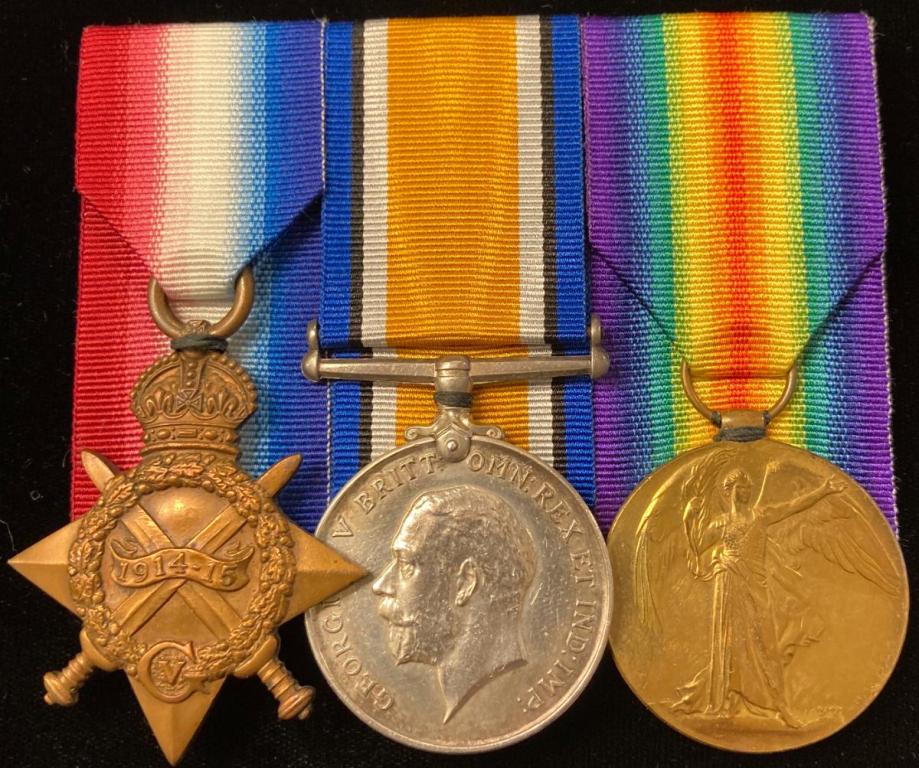
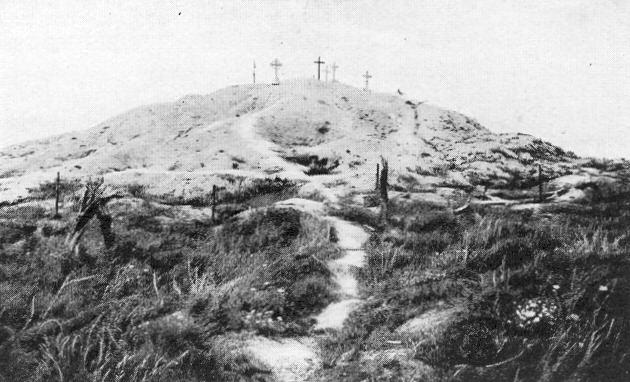
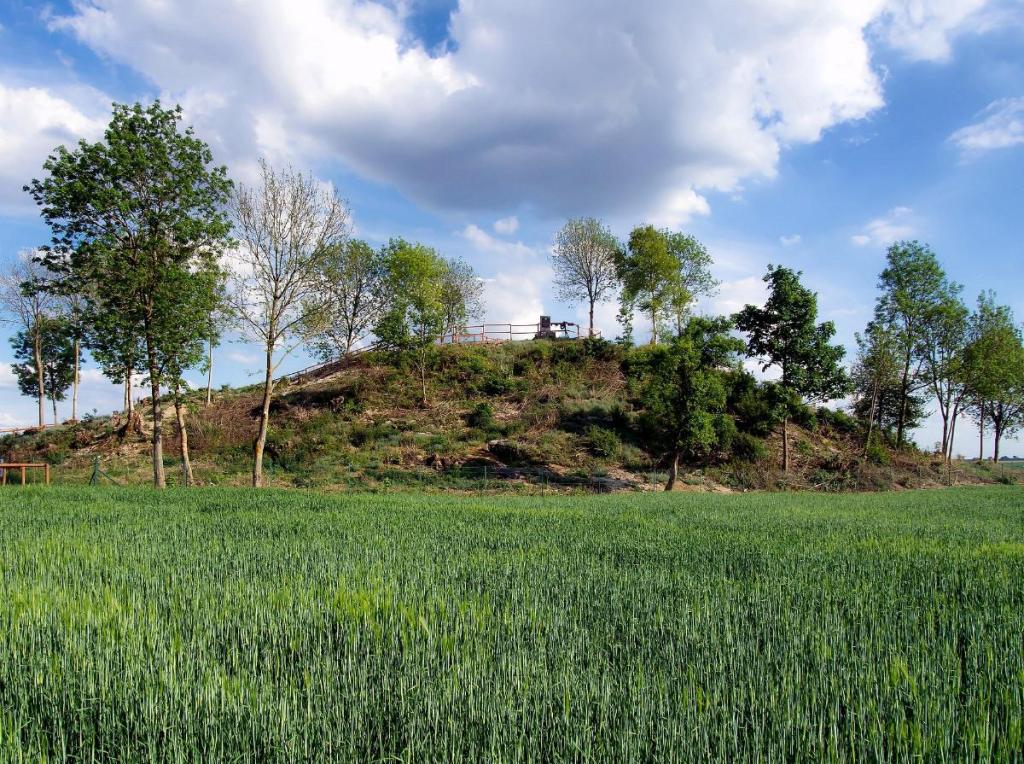
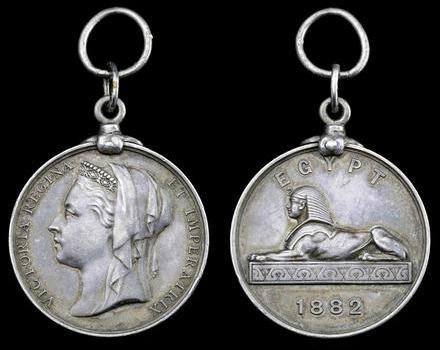


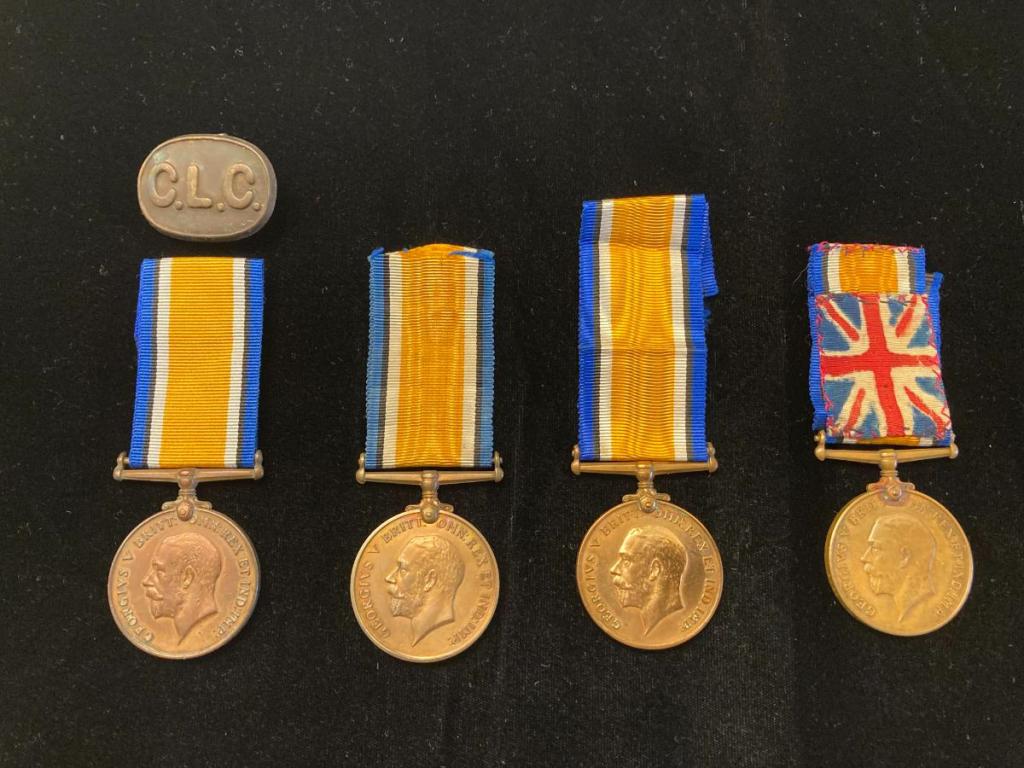

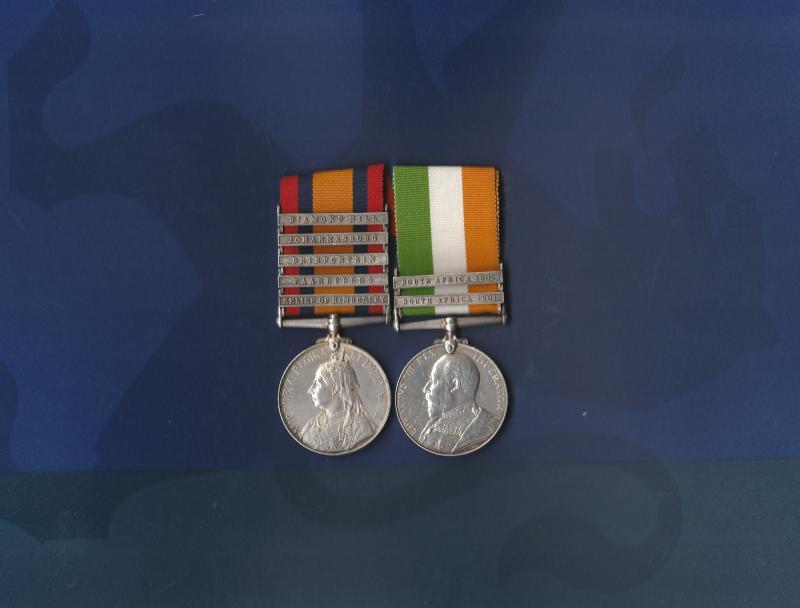
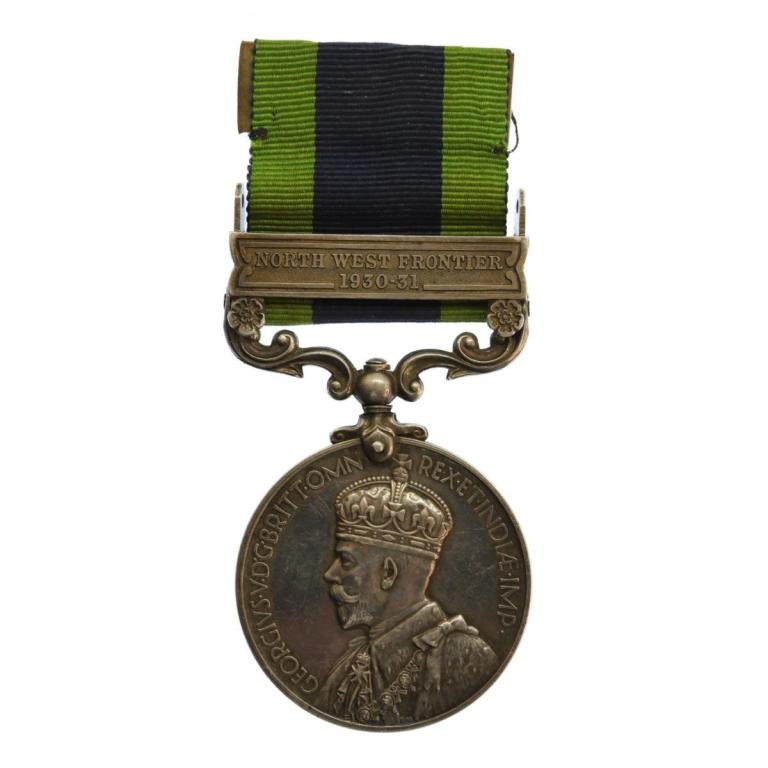
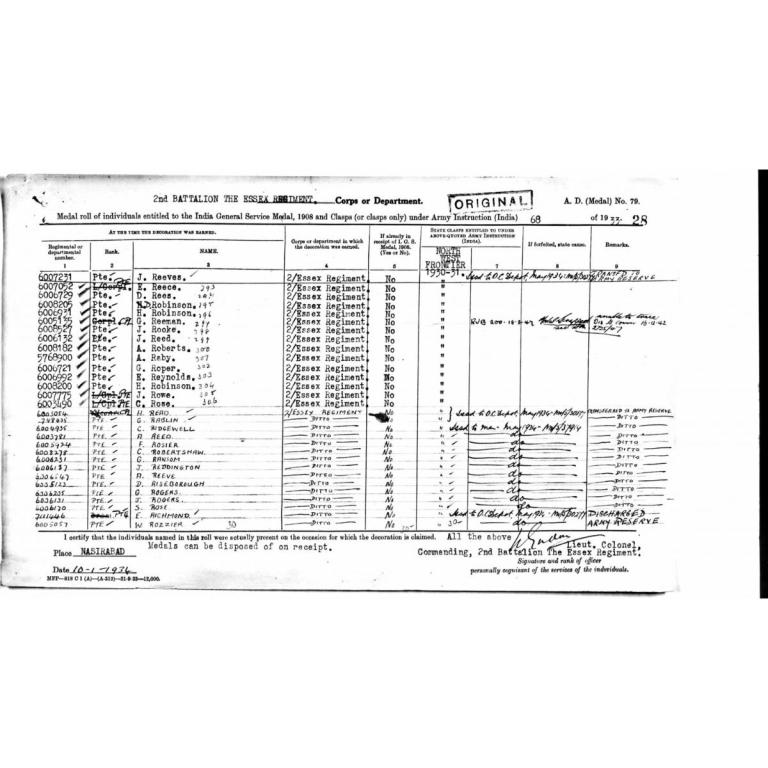
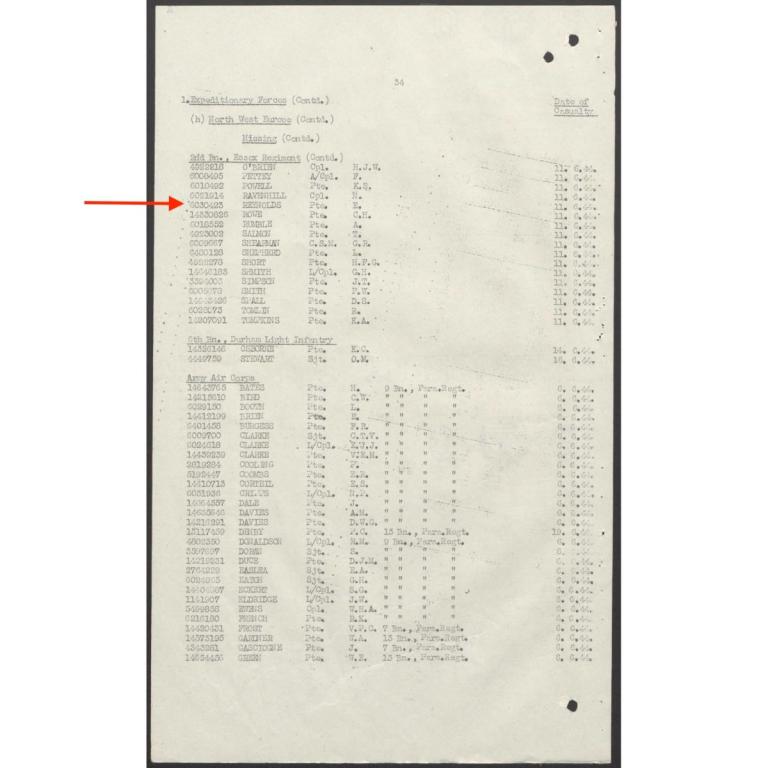
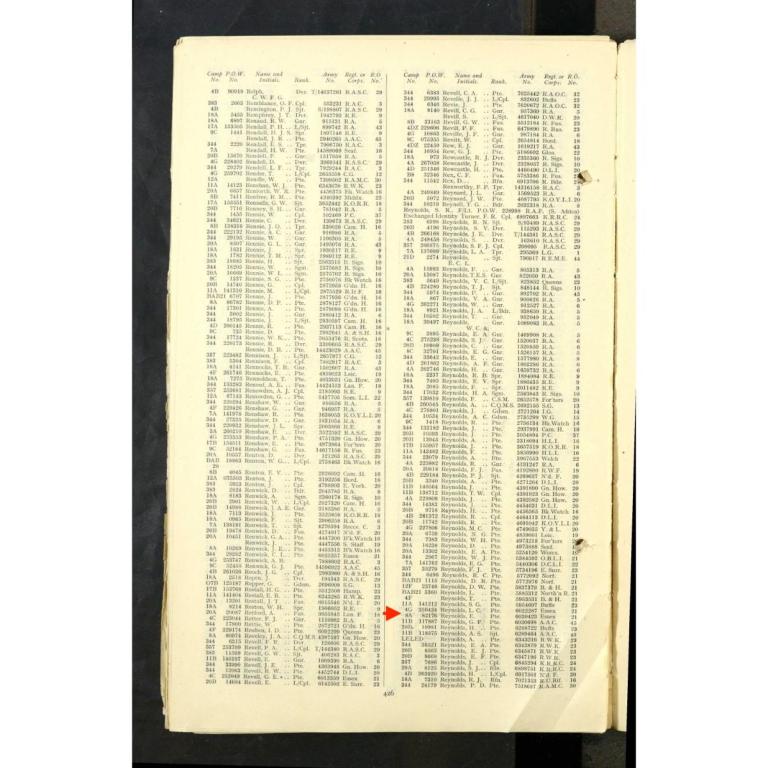
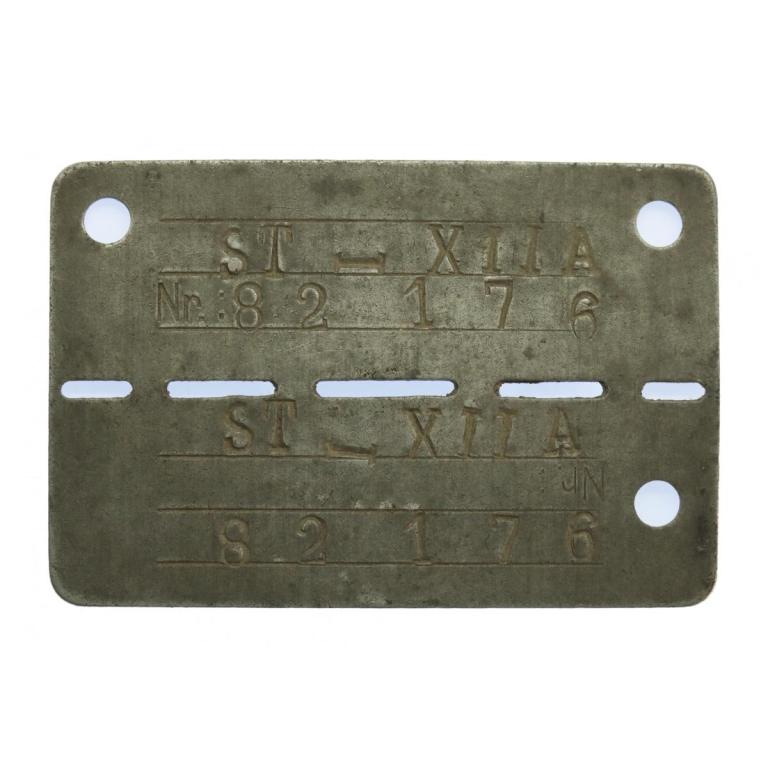


.thumb.jpeg.14ca23c7cc2dd53a539342a45072bbd7.jpeg)
.thumb.jpeg.13645159edd4fd3d68237944eca82e60.jpeg)
.thumb.jpeg.f904a1493cbf42327a31ef674120dcdd.jpeg)
.thumb.jpeg.b64b50f9a0a3e912b7b78d92088ff499.jpeg)
.thumb.jpeg.6aed07bcbadbd1d39038ea78dcb48b2b.jpeg)
